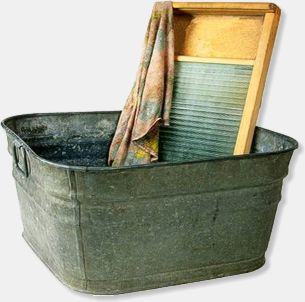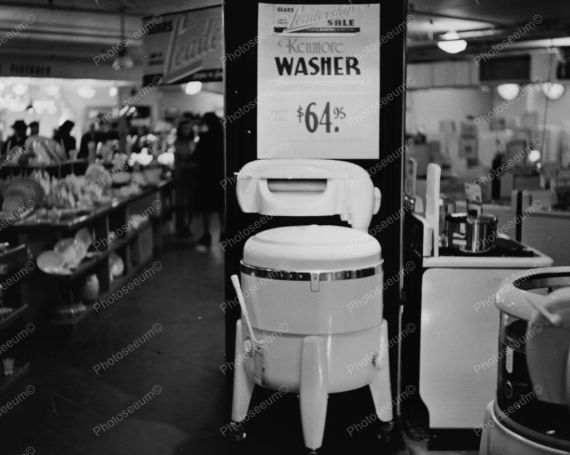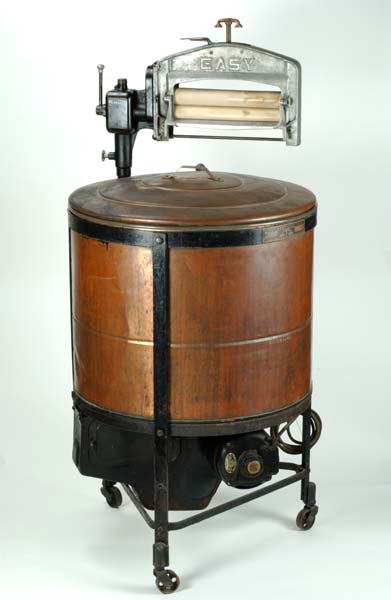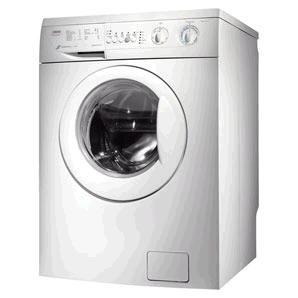
THE WASH TUB – AND THE KILLER WASH BOARD
Hey do you remember the old wash board and wash tub before the washing machine? For centuries, people on sea voyages washed their clothes by placing the dirty laundry in a strong cloth bag, and tossing it overboard, letting the ship drag the bag for hours. The principle was sound: forcing water through clothes to remove dirt. Catharine Beecher, an early advocate of bringing order and dignity to housework, called laundry “the American housekeeper’s hardest problem”. Women from all classes tried to find ways to get relief from doing laundry. Some hired washerwomen and others used commercial laundries. Eventually mechanical aids lightened the load.
“In the early days, without running water, gas, or electricity even the most simplified hand-laundry used staggering amounts of time and labor. One wash, one boiling and one rinse used about fifty gallons of water—or four hundred pounds—which had to be moved from pump or well or faucet to stove and tub, in buckets and wash boilers that might weigh as much as forty or fifty pounds. Rubbing, wringing, and lifting water-laden clothes and linens, including large articles like sheets, tablecloths, and men’s heavy work clothes, wearied women’s arms and wrists and exposed them to caustic substances.
They lugged weighty tubs and baskets full of wet laundry outside, picked up an article, hung it on the line, and returned to take it all down; they ironed by heating several irons on the stove and alternating them as they cooled, never straying far from the hot stove.” |
| |
The First Washing Machines The earliest manual washing machines imitated the motion of the human hand on the washboard, by using a lever to move one curved surface over another and rubbing clothes between two ribbed surfaces. This type of washer was first patented in the United States in 1846 and survived as late as 1927 in the Montgomery Ward catalogue. The first electric clothes washers, in which a motor rotated the tub, were introduced into America about 1900. The motor was not protected beneath the machine and water often dripped into it causing short-circuits and jolting shocks. By 1911, it was possible to buy oscillating, cylinder, domestic washing machines with sheet metal tubs mounted on angle-iron frames with perforated metal or wooden slat cylinders inside. |
Manufacturing Challenges From a technological perspective, washing machine manufacturers faced a number of challenges. These included discovering a method of transferring power from the motor to the mechanism, finding a suitable motor with sufficient initial starting torque, and ensuring that the operator did not get an electrical shock during operation.
A MORE MODERN VERSION OF THE WASHING MACHINE – NOTE PRICE
In the transference of power, some washing machines were chain driven, some belt driven and others used shafts and gears.
To overcome the initial resistance in starting a washing machine, a fractional horsepower motor which would not burn out or overheat during the start-up period was used. This was usually a 1/8 or ¼ horsepower motor, manufactured out-of-house by Westinghouse or Robbins and Myers.
To prevent electric shocks, the stator and rotor of the machine were enclosed in a housing equipped with a fan to prevent overheating.
Improvements From the customer satisfaction perspective, a machine that would wash without shredding the clothes needed to be developed. This meant that if the original scrubbing machines were used, the machine had to be operated at different speeds for different textiles. To overcome the problem, washing machines that sloshed water through the clothing by agitation were developed. Either the tub moved or a baffle placed inside the tub moved.

PROGRESS – NOTE WRINGER
Early washing machines had a heavy, dirty, cast-iron mechanism mounted on the inside of the tub lid. The introduction of a metal tub and reduction gears to replace this bulky apparatus was a great improvement. By 1920, the coopered wooden tub was no longer being manufactured.
Beatty Brothers of Fergus, Ontario was the first company to produce an agitator washing machine. The early Beatty machines had ribbed copper tubs which were nickel or nickel-chromium plated. In the US, the first firm to adopt agitator technology was Maytag. The vertical orientation of these machines became the industry standard replacing the horizontal rotating axis of earlier machines.
Starting in the 1920s, white enamelled sheet metal replaced the copper tub and angle-iron legs. By the early 1940s, enamelled steel was used and sold as being more sanitary, easier to clean and longer lasting than the other finishes. The sheet-metal skirt was also designed to extend below the level of the motor mount.
In the early 1920s, a number of Canadian machines were offered with built-in gas or electric water heaters. By the 1930s, domestic water heaters were in many homes and the washing machine heater was of little use. The addition of a motor-driven drain pump at this time moved the machine one step closer to complete automaticity.
The next development of the washing machine was the fitting of a clock timing device which allowed the machine to be set to operate for a pre-determined length of wash cycle. Now, the operator no longer needed to constantly monitor its action.
By the early 1950s, many American manufacturers were supplying machines with a spin-dry feature to replace the wringer which removed buttons, and caused accidents involving hair and hands. In 1957, GE introduced a washing machine equipped with 5 push buttons to control wash temperature, rinse temperature, agitation speed and spin speed.
(I remember some of the early versions of the washing machine the wringer presented a problem because you could get you hand stuck between the rollers and go up to your elbow before it would jam and stop. The newer versions would spring open if what you put in there was too thick or in case it was your arm. When I was on the Lakes after the first year when I came home I bought my mother a wringer washer from Bonnells in Sydney Mines. What a luxury. CAPER) |
The earliest washing machine was the scrub board. Ancient peoples cleaned their clothes by pounding them on rocks or rubbing them with abrasive sands; and washing the dirt away in local streams. Evidence of ancient washing soap was found at Sapo Hill in Rome, where the ashes containing the fat of sacrificial animals was used as a soap.

AN EARLY MODEL OF THE WASHING MACHINE – ELECTRIC
Scrub Board The earliest washing “machine” was the scrub board invented in 1797. American, James King patented the first washing machine to use a drum in 1851, the drum made King’s machine resemble a modern machine, however it was still hand powered.
Rotary Washing Machine In 1858, Hamilton Smith patented the rotary washing machine.
In 1874, William Blackstone of Indiana built a birthday present for his wife. It was a machine which removed and washed away dirt from clothes. The first washing machines designed for convenient use in the home.
Mighty Thor The Thor was the first electric-powered washing machine. Introduced in 1908 by the Hurley Machine Company of Chicago, Illinois, the Thor washing machine was invented Alva J. Fisher. The Thor was a drum type washing machine with a galvanized tub and an electric motor. A patent was issued on August 9th 1910.
Facts About a Few Famous Washing Machine Companies The Maytag Corporation began in 1893 when F.L. Maytag began manufacturing farm implements in Newton, Iowa. Business was slow in winter, so to add to his line of products he introduced a wooden-tub washing machine in 1907. Maytag soon devoted himself full-time to the washing machine business.
The Whirlpool Corporation started in 1911 as the Upton Machine Co., founded in St. Joseph, Michigan, to produce electric motor-driven wringer washers.
The origins of the Schulthess Group goes back over 150 years. In 1909, they began production of their first washing machines. In 1949, the Schulthess Group backed the invention of punched card control for washing machines. In 1951, production of Europe’s first automatic washing machines started. In 1978, the first microchip-controlled automatic washing machines were produced.

YOU HAVE COME A LONG WAY BABY – AND ABOUT TIME
(The Kenmore Washing Machine – My sister Judy sells hundreds of Kenmores each year and makes a fortune at it so much so that she plans to retire early and take up crocheting. CAPER)





Posted by Patricia on February 19, 2011 at 10:10
What memories these pictures bring back ,life was not easy back in the day.I still have a wash board ,there is nothing better to get your white socks clean.I do not use it anymore because it is so old and I often show it to friends and family so they know what it was like back in the day to wash your clothes .Patricia
Posted by CAPER on February 19, 2011 at 10:16
When Carmen and I were first married in Moncton she was washing everything in the tub in a very small apt. One day I called in to Eaton’s to buy a wash board. The salesman looked at me and said surely you wouldnt buy your new bride a wash board here is an outstanding washing machine with a wringer. Progress from then on lol